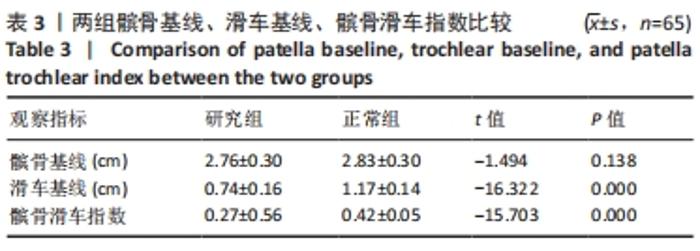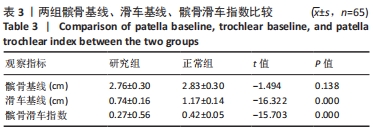[1] YIM JH, SEON JK, KIM YK, et al. Anterior translation and rotational stability of anterior cruciate ligament-deficient knees during walking: speed and turning direction. J Orthop Sci. 2015;20(1):155-162.
[2] EGLOFF C, SAWATSKY A, LEONARD T, et al. Alterations in patellofemoral kinematics following vastus medialis transection in the anterior cruciate ligament deficient rabbit knee. Clin Biomech (Bristol,Avon). 2014;29(5):577-582.
[3] KARIKIS I, DESAI N, SERNERT N, et al. Comparison of anatomic double and single bundle techniques for anterior cruciate ligament reconstruction using hamstring tendon autografts:a prospective randomized study with 5 year clinical and radiographic follow up. Am J Sports Med. 2016;44(5):1225-1236.
[4] MAYR HO, BENECKE P, HOELL A, et al. Single bundle versus double bundle anterior cruciate ligament reconstruction:a comparative 2 year follow up. Arthroscopy. 2016;32(5):34-42.
[5] NIZIC D. Comparison of positions of the trochlear groove line and the vertical midline of the pericondylar rectangle on axial computed tomography:a retrospective pilot study. Skeletal Radiol. 2012;41:1099-1104.
[6] BIEDERT RM, ALBRECHT S. The patellotrochlear index: a new index for assessing patellar height. Knee Surg Sports Traumatol Arthrosc. 2006;14(8):707-712.
[7] LIE MM, RISBERG MA, STORHEIM K, et al. What’s the rate of knee osteoarthritis 10 years after anterior cruciate ligament injury? An updated systematic review. Br J Sports Med. 2019;53(18):1162-1167.
[8] THEIN R, BOORMAN-PADGETT J, KHAMAISY S, et al. Medial Subluxation of the Tibia After Anterior Cruciate Ligament Rupture as Revealed by Standing Radiographs and Comparison With a Cadaveric Model. Am J Sports Med. 2015;43(12):3027-3033.
[9] BRADY JM, ROSENCRANS AS, SHUBIN STEIN BE. Use of TT-PCL versus TT-TG. Curr Rev Musculoskelet Med. 2018;11(2):261-265.
[10] 何容涵,李智勇,史德海,等.髌股关节不稳相关解剖结构的MRI分析[J].中华解剖与临床杂志,2015,20(3):191-195.
[11] SAPER MG, POPOVICH JM, FAJARDO R, et al. The Relationship Between Tibial Tubercle–Trochlear Groove Distance and Noncontact Anterior Cruciate Ligament Injuries in Adolescents and Young Adults. Arthroscopy. 2016;32(1):63-68.
[12] MICHAEL J. ROSSI MD. Editorial Commentary Tibial Tubercle-Trochlear Groove Distance as an Independent Risk Factor for Noncontact Anterior Cruciate Ligament Injury Is Possible but Remains Uncertain. Arthroscopy. 2016;32(1):69-70.
[13] 王震宇,孙学斌,李纲,等. 前十字韧带重建术前后 TT-TG 的变化及临床意义[J]. 新疆医学,2016,46(9):1070-1072.
[14] 刘丽思,郑卓肇,袁慧书.前交叉韧带单束重建术和双束重建术的股骨滑车与胫骨结节的水平距离(TTTG)比较[J].中国运动医学杂志,2015,34(12): 1147-1151.
[15] MONK AP, DOLL HA, GIBBONS CL, et al. The patho-anatomy of patellofemoral subluxation. J Bone Joint Surg Br. 2011;93(10):1341-1347.
[16] VAN DE VELDE SK, GILL TJ, DEFRATE LE, et al. The Effect of Anterior Cruciate Ligament Deficiency and Reconstruction on the Patellofemoral Joint. Am J Sports Med. 2008;36(6):1150-1159.
[17] 李康华,张俊,罗令,等.前交叉韧带不同断裂程度对髌骨内外侧关节面的生物力学影响[J].现代生物医学进展,2009,9(10):1898-1901.
[18] 闫斌,艾克帕尔·吾不利,桂和.MR定量测量指标在青少年髌骨不稳中的诊断应用价值[J].中国医药导报,2018,15(34):144-148.
[19] NTAGIOPOULOS PG, BONIN N, SONNERY-COTTET B, et al. The incidence of trochlear dysplasia in anterior cruciate ligament tears. Int Orthop. 2014;38(6): 1269-1275.
[20] DEGNAN AJ, MALDJIAN C, ADAM RJ, et al. Comparison of Insall-Salvati ratios in children with an acute anterior cruciate ligament tear and a matched control population. AJR Am J Roentgenol. 2015;204(1):161-166.
[21] 赵静,朱红霞,庞善军,等.髌骨高度与膝关节前交叉韧带撕裂之间相关性的MR研究[J].医学影像学杂志,2017,27(8):1561-1564.
[22] CHIBA K, TAKAHASHI T, HINO K, et al. Surgical treatment of simultaneous rupture of the anterior cruciate ligament and the patellar tendon. J Knee Surg. 2013;26(11):40-44.
[23] HART HF, CROSSLEY KM, FELSON D, et al. Relation of meniscus pathology to prevalence and worsening of patellofemoral joint osteoarthritis: the Multicenter Osteoarthritis Study. Osteoarthritis Cartilage. 2018;26(7):912-919.
[24] 孙辉,白波,廖壮文,等.半月板不同切除术对髌股关节影响的生物力学研究[J].中华关节外科杂志(电子版),2009,3(1):51-57.
|





